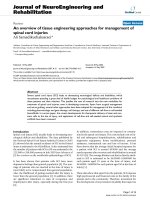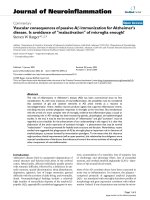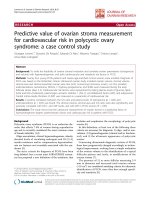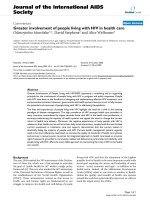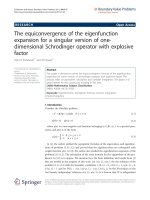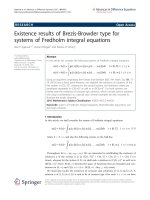Báo cáo hóa học: " Electrospray deposition of polymer thin films for organic light-emitting diodes" pot
Bạn đang xem bản rút gọn của tài liệu. Xem và tải ngay bản đầy đủ của tài liệu tại đây (279.14 KB, 13 trang )
Nanoscale Research Letters
This Provisional PDF corresponds to the article as it appeared upon acceptance. Fully formatted
PDF and full text (HTML) versions will be made available soon.
Electrospray deposition of polymer thin films for organic light-emitting diodes
Nanoscale Research Letters 2012, 7:52
doi:10.1186/1556-276X-7-52
Wontae Hwang ()
Guoqing Xin ()
Minjun Cho ()
Sung Min Cho ()
Heeyeop Chae ()
ISSN
Article type
1556-276X
Nano Express
Submission date
6 September 2011
Acceptance date
5 January 2012
Publication date
5 January 2012
Article URL
/>
This peer-reviewed article was published immediately upon acceptance. It can be downloaded,
printed and distributed freely for any purposes (see copyright notice below).
Articles in Nanoscale Research Letters are listed in PubMed and archived at PubMed Central.
For information about publishing your research in Nanoscale Research Letters go to
/>For information about other SpringerOpen publications go to
© 2012 Hwang et al. ; licensee Springer.
This is an open access article distributed under the terms of the Creative Commons Attribution License ( />which permits unrestricted use, distribution, and reproduction in any medium, provided the original work is properly cited.
Electrospray deposition of polymer thin films for organic light-emitting diodes
Wontae Hwang1, Guoqing Xin1, Minjun Cho1, Sung Min Cho1, and Heeyeop Chae*2
1
School of Chemical Engineering, Sungkyunkwan University (SKKU), Suwon, 440-746,
South Korea
2
SKKU Advanced Institute of Nanotechnology (SAINT), Sungkyunkwan University (SKKU),
Suwon, 440-746, South Korea
*Corresponding author:
Email addresses:
WH:
GX:
MC:
SMC:
HC:
Abstract
Electrospray process was developed for organic layer deposition onto polymer organic
light-emitting diode [PLED] devices in this work. An electrospray can be used to produce
nanometer-scale thin films by electric repulsion of microscale fine droplets. PLED devices
made by an electrospray process were compared with spin-coated ones. The PLED device
fabricated by the electrospray process showed maximum current efficiency of 24 cd/A, which
was comparable with that of the spin-coating process. The electrospray process required a
higher concentration of hole and electron transport materials in the inks than spin-coating
processes to achieve PLED maximum performance. Photoluminescence [PL] at 407 nm was
observed using electrosprayed poly(N-vinyl carbazole) films, whereas a peak at 410 nm was
observed with the spin-coated ones. Similar difference in peak position was observed
between aromatic and nonaromatic solvents in the spin-coating process. PLED devices made
by the electrospray process showed lower current density than that of spin-coated ones. The
PL peak shift and reduced current of electrosprayed films can therefore be attributed to the
conformation of the polymer.
Keywords: organic light-emitting diodes; electrospray, polymer, conformation.
Introduction
During the last two decades, intense academic and industrial research has been devoted on
organic light-emitting devices [OLEDs] due to their potential applicability to flat panel
displays and solid-state lighting [1-3]. Small areas of less than 5-in. devices have been
commercialized recently. Currently, all commercial processes adopt vacuum evaporation
processes for both organic and metal layer formations. However, vacuum evaporation
processes are significantly limited in large-area processing as well as hardware cost and
require a considerable material. These limitations and drawbacks prevent OLEDs from being
applicable to large-area device fabrication. Much effort has been made for solution process
development that can form nanoscale-thin organic films with a large area while minimizing
material wastes. A laboratory-scale spin-coating process is one of the most well known and
widely used solution processes. Various solution printing techniques have been developed
such as ink-jet printing, nozzle printing, screen printing, gravure printing, and so on. Thinfilm transfer process, organic vapor deposition, and blade coating are also being developed as
large-area, cost-effective alternatives [4-10]. However, challenges remain relating to good
uniformity over a large-area and multilayer formation without buffer or cross-linking
materials for commercial development of organic displays and lighting devices.
Recently, electrospray process has gained much attention as a solution process for organic
and inorganic thin films, and a few research groups have reported applications to organic
device fabrications [11-13]. In the electrospray process, a liquid flow is injected into the
nozzle with an electric field applied between the nozzle tip and ground plate, and microscale
monodisperse fine droplets are generated due to repulsion forces between like charges in the
drops. The size of droplets can be controlled by adjusting the flow rate and electric field
applied to the injection nozzles and substrates, and the diameter of the droplets can be as
small as several hundred nanometers in scale [14-16]. The electrospray process with vapor
treatment has been applied to organic photovoltaic fabrication, while comparable power
conversion efficiency has been reported with the spin-coating process [13]. Additionally,
applicability of the electrospray process to organic thin films in OLEDs was demonstrated in
small-scale devices [12].
In this work, we demonstrated nanoscale-thick organic thin films using the electrospray
process as a solution process alternative. Polymer LEDs [PLEDs] were fabricated and
compared with those made by the spin-coating process. The electrospray process can be
considered as an effective process for patterning, multilayer stacking, and continuous
processing of organic thin films.
Experimental details
For PLED fabrication, we used a blended solution of poly(N-vinyl carbazole) [PVK], 2-(4biphenylyl)-5-(4-tert-butylphenyl)-1,3,4-oxadiazole [PBD], N,N’diphenyl-N,N’-Bis(3methylphenyl)-[1,1-biphenyl]-4,4’-diamine [TPD], and tris(2-(4-tolyl) phenylpyridine)
iridium [Ir(mppy)3] dissolved in chlorobenzene [CB], dichlorobenzene [DCB], or a mixture
of CB and 1,2-DCB. Two different types of inks were formulated as shown in Table 1. PLED
devices were fabricated with a ratio of PVK/PBD/TPD/Ir(mppy)3 = 61:24:9:6 (ink 1) for both
the spin-coating and electrospray processes. The PBD/TPD ratio was increased for the
electrospray process. CB is best for the spin-coating process among the solvents mentioned
earlier, and DCB addition is required for the electrospray process.
The layer structure of the devices was as follows: indium tin oxide [ITO]/poly(3,4-
ethylenedioxythiophene) poly(styrenesulfonate) [PEDOT:PSS]/active layer/metal cathode. A
hole-injection PEDOT:PSS layer of 30-nm thick was first spin-coated on pre-cleaned ITO
substrates and then baked at 120°C for 20 min. About 80-nm-thick emissive layer [EML] was
formed by electrospray or spin-coating process and then annealed at 80°C for 30 min. A
schematic diagram of the experimental setup for the electrospray process is shown in Figure 1.
For the electrospray process, the blend ink was injected through the nozzle at a rate of 30
µl/min, and about 3 kV was applied to break the meniscus formed at the tip of the nozzle.
The distance between the tip of the nozzle (150 µm in diameter) and the substrate was
maintained at 3 to 4 cm. During spraying, the nozzle and substrate were fixed, and the
thickness of EML was controlled by varying the deposition time. For the comparative spincoating process, the solution was spin-coated at 2,000 rpm for 20 s. All the experiments were
carried out at 20°C to 25°C and a humidity of 30% to 35%. The interlayer and cathode were
thermally evaporated on the top of the EML at a pressure of 2 × 10−5 Torr.
All electrical measurements were performed under ambient conditions. Device performance
was measured using a source measure unit (2400, Keithley Instruments, Inc., Cleveland, OH,
USA) and a luminance meter (CS100, Konica Minolta Sensing, Inc., Sakai, Osaka, Japan).
Photoluminescence [PL] spectra were collected with a monochromatized 150-W Xe light
source (FP-6200, Jasco International Co. Ltd., Hachioji, Tokyo, Japan), and a wavelength of
335 nm was used for analysis of PL excitation. The thickness and roughness of PVK films
were determined by a surface profiler (Alpha-Step, KLA-Tencor Corporation, Milpitas, CA,
USA) and by atomic force microscopy (Digital Instruments, Santa Barbara, CA, USA),
respectively.
Results and discussion
In electrospray deposition, it is critical to choose proper solvents to make fine droplets
and uniform thin films. Evaporation rate of the solvent, which is determined by its boiling
point, is an important factor to consider. Dielectric constant is another crucial physical
property of solvents in determining the size of droplets and droplet dispersion. Further, high
dielectric constant and high boiling point are preferred in electrospray processing.
Specifically, 1,2-DCB (dielectric constant [ε] = 10, boiling point = 180°C) is added to CB (ε
= 5, boiling point = 130°C) [17] to balance solubility and droplet control. The concentration
of droplets at the time of deposition is then controlled by managing the droplet size. Droplets
containing little solvent or almost dry particles can be deposited when a low-boiling point
solvent is used at a slow flow rate. This mode of operation is called the dry mode, and a few
groups have reported a dry-mode operation. [18] In this work, droplets containing a rather
large fraction of solvents were transferred to substrates, and therefore, the films required time
for solvent evaporation after the deposition. As shown in Figure 2, 70- to 150-nm-thick lightemitting organic layers with about 1-nm surface roughness were formed by the electrospray
process in this work.
To investigate the characteristics of organic light-emitting layers made by the
electrospray deposition process, we adopted organic light-emitting materials of PVK as a host
polymer with Ir(mppy)3 added as a dopant. Further, TPD and PBD were added to facilitate a
hole and electron transport. We performed experiments with our standard composition, ink
(1) in Table 1, and the device made with the spin-coating process with ink (1) is shown with
sample 1 in Figure 3. When we used the same ink (1) in the electrospray process, the current
efficiency significantly decreased by up to 38% (sample 2). We believe from the cause was an
imbalance in charge transport in the device, and we were able to achieve similar performance
by formulating ink (2) with increased hole and electron transport materials as shown with
sample 5 in Figure 3. Samples 5 and 6 show the effects of the solvent in the electrospray
process. Better device performance was achieved with a solvent mixture of CB/DCB = 5:3.
DCB helps maintain a stable and uniform spray, but too much DCB lowers device
performance since it cannot be removed sufficiently during the annealing process due to its
high boiling point. This result indicates that solvent optimization can regulate film and device
performance made by the electrospray process. The summary of device performances is in
Table 2.
To investigate the difference between electrospray and spin-coating processes, PVK
thin films were formed by two different processes, and their electric and PL characteristics
were investigated. As mentioned earlier, development of a proper solvent is an important step
in the electrospray process. Accordingly, we also investigated the effects of solvents on
electric and PL film characteristics. Figure 4 shows the effects of solvents and process
method on PL characteristics. We chose two different types of solvents: an aromatic solvent
which comprised a mixture of CB and DCB and non-aromatic solvents, chloroform [CF] and
1,2-dichloroethane [DCE]. The mixture of CB and DCB was selected as it was optimum for
our device structure and process. The PL peaks of the thin films were observed at 407 nm
with CF and DCE and at 410 nm with the aromatic solvent mixture. Using the same aromatic
solvent, PVK films processed by the electrospray process showed PL peaks at 407 nm, while
those made by spin-coating showed PL peaks at 410 nm. Qian et al. [19] reported a peak shift
of PVK due to polymer conformation caused by the solvent effect. We believe that a similar
polymer conformation effect results not only from the solvent, but also from the processing
method as shown in this work. Figure 5 shows the current-voltage characteristics of the PVK
film using different solvents and processing methods. At the same thickness, the thin films
using the aromatic solvent (mixture of CB and DCB) showed a higher current density than
those processed with the DCE nonaromatic solvent. In terms of processing methods, the PVK
film processed with the electrospray method showed a lower current density than that of spincoated ones. These results suggest that polymer conformation of PVK thin films was affected
by the processing method as well as by the solvent's molecular structure as also indicated in
PL results in Figure 4. Based on these results, we speculate that the properties of thin films
made by the electrospray process are similar to those of spin-coated films made with DCE.
Conclusion
We have demonstrated polymer organic LEDs using an electrospray process as a solution
process alternative. Device performance comparable to spin-coating was achieved with the
electrospray process, which can be considered as a scalable large-area process alternative.
However, the electrospray process requires elaborate choices involving solvents and higher
concentrations of hole and electron transport materials in active materials. A high dielectric
constant and a high-boiling point solvent like DCB are preferred in electrospray processing.
Accordingly, the device based on the electrospray process had better performance when we
used the ink having higher concentrations of hole and electron transport materials. The
electrospray process can be considered as a viable solution for large-area organic thin-film
formation technology in the future.
Competing interests
The authors declare that they have no competing interests.
Authors' contributions
WH carried out the overall experiment. GX helped in the PL measurement. MC participated
in the device fabrication. SMC and HC gave advice for this work. All authors read and
approved the final manuscript.
Acknowledgments
This research was supported by the Basic Science Research Program through the National
Research Foundation of Korea (NRF) funded by the Ministry of Education, Science and
Technology (2011-0012279) and (2011- 0006268).
References
1. Tang CW, VanSlyke SA: Organic electroluminescent diodes. Appl Phys Lett 1987,
51:913-915.
2. Burroughes JH, Bradley DDC, Brown AR, Marks RN, Mackay K, Friend RH, Burns PL,
Holmes AB: Light-emitting diodes based on conjugated polymers. Nature 1990,
347:539-541.
3. Baldo MA, O’Brien DF, You Y, Shoustikov A, Sibley S, Thompson ME, Forrest SR:
Highly efficient phosphorescent emission from organic electroluminescent
devices. Nature 1998, 395:151-154.
4. Baldo M, Deutsch M, Burrows P, Gossenberger H, Gerstenberg M, Ban V, Forrest S:
Organic vapor phase deposition. Adv Mater 1998, 10:1505-1514.
5. Hebner TR, Wu CC, Marcy D, Lu MH, Sturm JC: Appl Phys Lett 1998, 72:519-521. Inkjet printing of doped polymers for organic light emitting devices
6. Pardo DA, Jabbour GE, Peyghambarian N: Application of screen printing in the
fabrication of organic light-emitting devices. Adv Mater 2000, 12:1249-1252.
7. Tseng S-R, Meng H-F, Lee K-C, Horng S-F: Multilayer polymer light-emitting diodes
by blade coating method. Appl Phys Lett 2008, 93:153308-153303.
8. Kopola P, Tuomikoski M, Suhonen R, Maaninen A: Gravure printed organic light
emitting diodes for lighting applications. Thin Solid Films 2009, 517:5757-5762.
9. O’Regan M: Solution processed OLED displays: advances in performance, resolution,
lifetime and appearance. SID Symp Digest Tech Pap 2009, 40:600-602.
10. Jin H, Sturm JC: Super-high-resolution transfer printing for full-color OLED display
patterning. J Soc Inf Display 2010, 18:141-145.
11. Saf R, Goriup M, Steindl T, Hamedinger TE, Sandholzer D, Hayn G: Thin organic films
by atmospheric-pressure ion deposition. Nat Mater 2004, 3:323-329.
12. Ju J, Yamagata Y, Higuchi T: Thin-film fabrication method for organic light-emitting
diodes using electrospray deposition. Adv Mater 2009, 21:4343-4347.
13. Kim J-S, Chung W-S, Kim K, Kim DY, Paeng K-J, Jo SM, Jang S-Y: Performance
optimization of polymer solar cells using electrostatically sprayed photoactive
layers. Adv Funct Mater 2010, 20:3538-3546.
14. Wilhelm O, Mädler L, Pratsinis SE: Electrospray evaporation and deposition. J
Aerosol Sci 2003, 34:815-836.
15. Rietveld IB, Kobayashi K, Yamada H, Matsushige K: Electrospray deposition, model,
and experiment: toward general control of film morphology. J Phys Chem B 2006,
110:23351-23364.
16. Jaworek A, Sobczyk AT: Electrospraying route to nanotechnology: an overview. J
Electrostat 2008, 66:197-219.
17. Lide DR: Handbook of Organic Solvents. Boca Raton: CRC Press; 1995.
18. Kim JW, Yamagata Y, Kim BJ, Higuchi T: Direct and dry micro-patterning of nanoparticles by electrospray deposition through a micro-stencil mask. J
Micromechanics Microengineering 2009, 19:025021.
19. Qian L, Bera D, Holloway PH: Electrophosphorescence from triplet excimers in poly(N-vinylcarbazole). Appl Phys Lett 2007, 90:103511-103513.
Figure 1. Schematic description of the electrospray process used for PLED fabrication.
Figure 2. PVK film thickness and roughness as a function of deposition time.
Figure 3. Device performance of the devices made by spin-coating or electrospraying.
The thicknesses of EML were as follows: (1) 78, (2) 100, (3) 120, (4) 70, (5) 100, and (6) 103
nm.
Figure 4. PL spectra of PVK films spin-coated or electrosprayed from the solvents
(CB/DCB, DCE, or CF). (a) Normal view. (b) Enlarged view of (a). All spectra are
normalized to their maximum value, and the excitation wavelength was fixed at 335 nm.
Figure 5. Current density-voltage curve of PVK devices using spin-coating and
electrospray deposition (ITO/PEDOT:PSS/PVK/CsF/Al). The thin films using CB/DCB
showed a better current density under the same conditions.
Table 1. Ratio of the PLED ink
Ink 1a
Ink 2a
PVK
61
41.5
PBD
24
41.5
TPD
9
14.8
Ir(mppy)3
6
4.2
a
Each figure means weight percent of materials in the solution, and the main difference
between Ink 1 and Ink 2 is the ratio of hole and electron transport materials. PVK, poly(Nvinyl carbazole); PBD, 2-(4-biphenylyl)-5-(4-tert-butylphenyl)-1,3,4-oxadiazole; TPD,
N,N’diphenyl-N,N’-Bis(3-methylphenyl)-[1,1-biphenyl]-4,4’-diamine; Ir(mppy)3, tris(2-(4tolyl) phenylpyridine) iridium.
Table 2. Summary of device performances
Device
Process
Ink
Solvent
EML
(nm)
1
Spin-coating
Ink 1
CB
78
2
Electrospray
Ink 1
CB/DCB (5:3)
100
3
Electrospray
Ink 1
CB/DCB (5:3)
120
4
Electrospray
Ink 2
CB/DCB (5:3)
70
5
Electrospray
Ink 2
CB/DCB (5:3)
100
6
Electrospray
Ink 2
CB/DCB (1:1)
103
EML, emissive layer; CB, chlorobenzene; DCB, dichlorobenzene.
Cd/A
(max)
24
15
18
18
24
23
Lm/W
(max)
10
6
6.6
7.5
9.2
8.6
Figure 1
Figure 2
Figure 3
Figure 4
Figure 5


